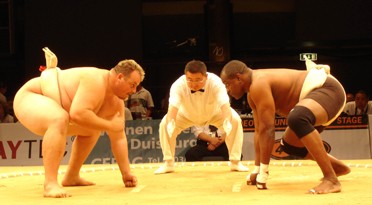| Yokozuna Comparisons Joe Kuroda |

 |
| Amateur Sumo's Global Aspirations Courtesy: International Sumo Federation |

 |
| Rikishi of Old Joe Kuroda |

 |
| Heya Peek Barbara Ann Klein |

 |
| SFM Interview Mark Buckton |

 |
| Sumo 101 Barbara Ann Klein |

 |
| Photo Bonanza See the Haru |
 |
| Haru Basho Review Lon Howard |

 |
| Lower Division Rikishi Mikko Mattila |

 |
| Natsu Basho Forecast Mark Buckton |

 |
| Kimarite Focus Mikko Mattila |

 |
| Sumo in Print Mark Buckton |

 |
| Kokugi Connections Todd Lambert |

 |
| Fan Debate Facilitator – Lon Howard |

 |
| SFM Cartoons Benny Loh & Stephen Thompson |

 |
| Let’s Hear From You What was it that |

 |
| Readers’ Letters See what some |

 |
Sumo Quiz
The Quizmaster
Answer the Qs and win yourself next basho’s banzuke.

Stanley Somerville (RSA) vs. James B. Thompson (USA) – World Games 2005
 Junior lightweight – under 75 kg, or 165 lbs
Junior lightweight – under 75 kg, or 165 lbs Junior middleweight – under 100 kg, or 220 lbs
Junior middleweight – under 100 kg, or 220 lbs Junior heavyweight – over 100 kg
Junior heavyweight – over 100 kgFrom 1980, we began holding international sumo tournaments. 1992 saw the holding of the first Sumo World Championships under the aegis of the IFS which was attended by a total of 73 competitors from 25 different countries and territories. Since then, the Sumo World Championships have been held annually and the number of participants has continued to increase. The 14th Sumo World Championships will be held on October 15th, 2006 in Sakai city, Osaka, Japan and promises to be once again a great success.
The IFS also continues in its bid to make sumo an Olympic Sport. There are 3 main sports bodies connected to the IOC – ARISF (Association of IOC Recognized International Sports Federations), IWGA (International World Games Association), and GAISF (General Association of International Sports Federations). One of the criteria
Next
The rules of amateur sumo are essentially the same as in professional sumo, with only a few differences. In amateur sumo there is less emphasis on the religious aspect of sumo and the trappings associated with professional sumo, such as the kesho-mawashi, are not used. There are two types of dohyo – the earth dohyo and the mat dohyo. The earthen dohyo is the same as in professional sumo, whereas the mat dohyo is made up of a plastic sheet with attached tawara being placed over mats. IFS often donates mat dohyo and mawashi to National Sumo Federations to help promote sumo. There are
 Men lightweight – up to 85 kg, or 187 lbs
Men lightweight – up to 85 kg, or 187 lbs Men middleweight – up to 115 kg, or 253 lbs
Men middleweight – up to 115 kg, or 253 lbs Men heavyweight – over 115 kg
Men heavyweight – over 115 kg Women lightweight – up to 65 kg, or 143 lbs
Women lightweight – up to 65 kg, or 143 lbs Women middleweight – up to 80 kg, or 178 lbs
Women middleweight – up to 80 kg, or 178 lbs Women heavyweight – over 80 kg
Women heavyweight – over 80 kg